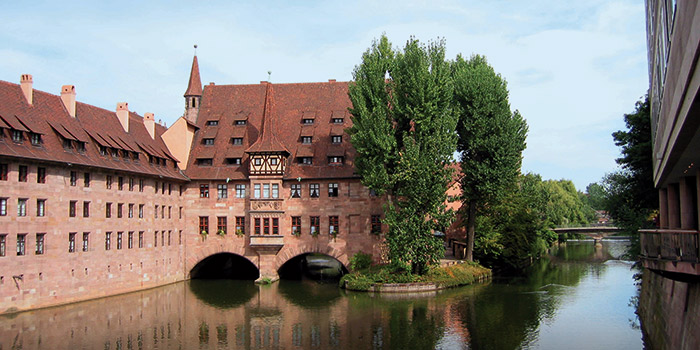
Nuremberg: Sunday August 21

ORIGINAL PLAN: After breakfast, disembark in Nuremberg and visit the ruins of Zeppelin Field, the Nazi parade grounds of the 1930s; then see the Palace of Justice, site of the infamous Nuremberg Trials. Alternately, you may take an optional World War II tour that includes the illuminating Documentation Center Museum. After lunch, spend free time exploring Nuremberg’s Old Town. Or, join an optional tour to discover the secret network of underground bunkers where priceless art was hidden in wartime. We depart just before dinner. (Breakfast, Lunch, Dinner provided)
Tour one of Germany’s most renowned and intriguing cities on this included excursion. Meet your guide at your ship, then drive to the Old Town, where you can delve into Nuremberg’s complex past. This medieval city is still surrounded by 14th-century walls, with many gates and watchtowers fully intact. It grew into a toy-making capital of Europe, where craftsmen also shaped metal into inspiring sculpture and carved wood and other materials into decorative crafts. After you see the grounds on which Nazi rallies were staged and pass the Palace of Justice, admire the Imperial Palace, one of Europe’s most formidable fortresses. Then, stroll down the castle hill past half-timbered houses and browse the stalls at the Market Square. One of Europe’s most celebrated, it is famous for its gingerbread and its Gothic Schöner Brunnen, or Beautiful Fountain. Cap your tour with time at your leisure to explore on your own.
* Moderate - Walking portions may be long and somewhat challenging with occasional step-ups, stairs and inclines. Total time walking or standing normally ranges from 1.5 to 3 hours.
Zoe: We stopped in Nuremberg and did the city tour. You need to buy the local gingerbread here. St. Sebaldus Lutheran church was bombed in WWII and they have photos of their reconstruction and pleas for peace that this doesn’t happen again. The stadium site used by Hitler had a very eerie feeling for me.
OUR EXPERIENCE:
An overview for the day with special insights was in the Viking Daily.
We disembarked about 9:00 am and took a bus into Nuremberg, Two guides from different parts of Bavaria: Franconia (red flag) and the other side Bavaria (blue flag) teased one another about local tensions as we drove past the stadium where Hitler held mass gatherings:
Front where Hitler appealed to the crowds
From the rear
Both guides were clearly against the Nazi movement and warned us how easily the masses can be duped into the totalitarian way. We could see the prison where the 11 Nazi leaders were held during the Nuremberg trials, then the courthouse where the trials were held:
The guide explained how most of the city was destroyed by massive bombings as in Dresden. We passed by the medieval city walls and nearby cemetery then parked so that the walking tour could begin. We later discovered that Barbara's 2nd great grandfather, Francis Louis Krebs was born in Ober, Altenberg, Bavaria, about a two hour drive way.
Barbara and I broke away from the group in search of a Catholic Church for mass. Using our map in the fog, we headed in the wrong direction until we spoke with a taxi driver who set us on the correct course, Then Barbara reminded me how well Google maps would direct our way on a walking tour to the Frauenkirche, the Church of Our Lady. As we did in Cologne, we chanced upon a protestant (Lutheran) church first. I asked someone in the church, "Catholic?" They responded, "It used to be, but the Lutherans took it over" By the time we arrived, the mass had finished, so we read the readings for the Sunday, prayed, and took pictures inside the church.
The Frauenkirche stands on the eastern side of the main market. An example of brick Gothic architecture, it was built on the initiative of Charles IV, Holy Roman Emperor between 1352 and 1362.
Later, we found a restaurant for coffee and croissants (light and flaky sprinkled with powdered sugar accompanied with a strawberry, blue berries and a sprig of mint). Later on, I found out that my mother's great-grandfather, William Fred Scherer, was born near southwest Nuremberg close to Dinkelsbuhl (Central Frankonia) in 1829. Franconia is part of Bavaria but Franconians resist this general classification and they especially resist the Bavarian stereotype that has morphed into the German stereotype – tall, blond people, beer quaffed from steins, beer bellies, lederhosen, sausages, sauerkraut and cuckoo clocks.
On the nearby plaza, we found a souvenir shop where we discovered some marionette Christmas tree decorations and a few refrigerator magnets. As we exited the shop, we ran into our original tour group, took a few pictures, then searched for the famous Nuremberg gingerbread. Every bakery and supermarket was closed for Sunday, so we were denied gingerbread:
Soon we were back on the bus to our ship. Lunch was served. I took pictures of the local beer and all the silverware set at each meal:
We were relieved to hear that we could remain on the same ship rather than having to transfer to the Viking Magni. We were also promised that the cruise would include the use of the top deck, for the first time, in a few days.
At dinner, I took a few pictures of the elegantly prepared meal. Each day, we had a choice of local cuisine or a variety of tasty entrees: